The 7 Best Construction Time Card Apps & Software in 2025
Discover the 7 best time card apps for construction and compare their features and pricing to find the option that’s the best fit for you.

Construction time card systems go beyond basic time tracking with features that improve oversight and accountability for crews that work in the field. In this post, we’re taking a look at the seven best time card apps for construction companies, highlighting their unique features and comparing their pricing so you can find the right option for your crew.
Overview of the best construction time tracking apps
Here’s a quick snapshot of the best construction timesheet apps and why they stand out. Click the link for any of the apps to jump down to our full reviews.
- Buddy Punch is the most affordable construction time card app. It’s an easy to use system with construction-specific features like GPS tracking, geofencing, job costing, variable pay rates, and built-in Spanish language translations.
- Workyard is the best solution for generating certified payroll reports and integrating with construction-specific software. It offers highly accurate GPS tracking, route mapping, and the ability to include Workers’ Comp codes in payroll processing.
- Timeero excels at offline tracking that saves location and time data when cell service is lost. It is designed for mobile crews and features robust GPS tracking, geofencing, mileage logging, and segmented time tracking for multiple job sites.
- ExakTime is best suited for multilingual crews due to its in-app translation into English, Spanish, and French. It is focused entirely on construction, offering real-time GPS, equipment tracking, and optional rugged physical time clock kiosks.
- ClockShark is ideal for getting real-time updates from the field using its unique clock-out questions feature. It also provides standard time tracking, scheduling, GPS monitoring, team chat, and easy document sharing for project files.
- ConstructionClock is unique for its automated time tracking that eliminates manual clock-in/out using geofencing. This system provides high-frequency GPS logging and includes features for task management and employee scheduling.
- BusyBusy is the best free construction timekeeping app, offering unlimited users, time tracking, job codes, and equipment location tracking on its no-cost plan. Paid plans add GPS location history and a unique safety sign-off feature for injury reporting.
How we chose the apps on this list
We started out by identifying a list of 36 apps that include the key features that construction companies need (e.g., GPS tracking, mobile apps, and job costing). Since construction crews work in the field at many different locations, it’s important that they can clock in and out from anywhere while giving owners and admins the data they need to keep track of their teams.
From there, we compared pricing for the 36 different options. We removed 16 options that were priced much higher than competitors even though the feature sets of the apps were identical.
Finally, we started free trials of the remaining 20 options and engaged in hands-on testing. We evaluated how easy the apps were to set up and use and made sure that all of the features (particularly GPS tracking) worked properly. The seven options we decided were the best were the ones that were the easiest to set up and use and offered the most features at the best price.
What is a construction time card app?
A construction time card app is a digital system used by construction companies to track, manage, and verify their employees’ work hours, particularly those working in the field across multiple job sites. It replaces traditional manual methods (like paper timesheets or punch cards) with an automated, mobile-friendly system.
The benefits of using construction time tracking solutions
Some of the biggest benefits of using a construction time tracking software include:
- Flexible punching: Employees can track time using mobile apps on their phones, allowing them to track their hours down to the second no matter where they’re working.
- Improved accuracy: Construction time card systems come with features like GPS tracking and geofencing that ensure your employees are on-site while on the clock and prevent time theft. Additionally, most have built-in timesheet approval systems that let a site foreman review and approve hours for their team before an admin runs payroll.
- Payroll efficiency: Time card apps automatically calculate work hours and pay for you, let you set up approval workflows for timesheets, and either integrate with payroll software or have construction payroll software built in.
- Job costing, project management, and budgeting: Employees can track time toward specific jobs, giving you real-time labor cost tracking by project and helping with cost control and forecasting. Additionally, some construction timekeeping apps also come with features like safety check-ins and the ability to upload project photos to keep office employees updated automatically.
- Improved compliance: Construction time tracking apps make it easy to keep accurate records for labor laws, overtime rules, and prevailing wage compliance.
Key features to look for in a construction time clock app
There are some core features you’ll want to look for that almost all time tracking software on the market will provide. These include mobile apps, payroll integrations, overtime tracking, break time tracking, and reporting. You’ll also want to choose a time clock app that’s easy for your crew to use.
However, as a construction business, there are time tracking features beyond these basics that you should also look for to make sure the app caters to the specific nuances of your industry:
- Job costing: Construction companies often work on multiple projects at once. A good time tracking app lets you easily assign the hours employees work to specific job codes to accurately track time, project, and labor costs.
- GPS tracking: GPS tracking features can help you verify that employees are at the correct job sites when they clock in and out, let you track employees’ locations in real-time throughout the workday, or allow you to view breadcrumb trails of where employees traveled while on the clock.
- Mileage tracking: Tracking mileage can be useful if you need to reimburse employees for the miles they travel in their own vehicles for work.
- Geofencing: Geofencing features let you limit where employees can clock in and out to specific locations, ensuring that no one is able to track time before arriving at a worksite or after they’ve already left. Some apps will also use geofences to automatically clock employees in and out of specific projects or remind employees to clock in/out when entering/leaving a geofence.
- Variable wage rates: If your crews commonly work prevailing wage jobs, you’ll need a time clock app that allows you to set employee wages per project to automatically calculate exactly how much employees should get paid.
- Offline capabilities: Job sites won’t always have internet access, and in more remote areas, mobile signals may be sparse too. Your time card app should let crew members track time even when they’re in areas with poor or no internet access.
- Multiple clock-in/out options: If your employees don’t all have mobile devices, look for a tool that allows employees to track time in other ways, such as by sending a text message, using a kiosk, or group punch by a foreman.
- Photo punching/facial recognition: Since there’s not always a manager or foreman at sites at the same time as crew members, features like photo punching (requiring an employee to take a selfie when clocking in and out) and facial recognition help prevent time theft acts like buddy punching.
You may also want to look for apps with features that allow crew members to add project photos to their time entries, have built-in safety check-in forms employees have to complete when clocking out, or that let you track the locations of your equipment. Additionally, if you do government or prevailing wage work, you’ll want to look for apps that can generate certified payroll reports automatically.
The 7 best time card apps for construction companies
Below, you’ll find our detailed reviews of the seven best time card apps for construction companies, including information about what types of teams they’re best for, what their current customers like about them, and how much they cost.
| App | Best For | G2 Rating | Starting Price |
|---|---|---|---|
| Buddy Punch | Affordability and ease of use | 4.8/5 | $4.49/user/month |
| Workyard | Certified payroll reports | 4.7/5 | $6/user/month |
| Timeero | Offline tracking | 4.8/5 | $44/user/year |
| ExakTime | Multilingual crews | Not rated | $9/user/month |
| ClockShark | Real-time updates from the field | 4.6/5 | $9/user/month |
| ConstructionClock | Automated time tracking | Not rated | $10/user/month |
| BusyBusy | Free time tracking | 4.8/5 | $9.99/user/month |
1. Buddy Punch – Best construction time card app for affordability and ease of use

Buddy Punch packs both basic time tracking functionality and construction-specific features into one easy-to-use and affordable platform. It has all the tools you need to manage your construction operations: track time, schedule employees, and process payroll. Plus, its mobile apps let your crew punch in and out using their phones no matter where they’re working.
One of Buddy Punch’s biggest benefits is that employees don’t need unique email addresses for you to create accounts for them — an unlimited number of unique employee accounts can be created with a single admin email address. Beyond that, it offers all of the features that construction crews need.
Job costing
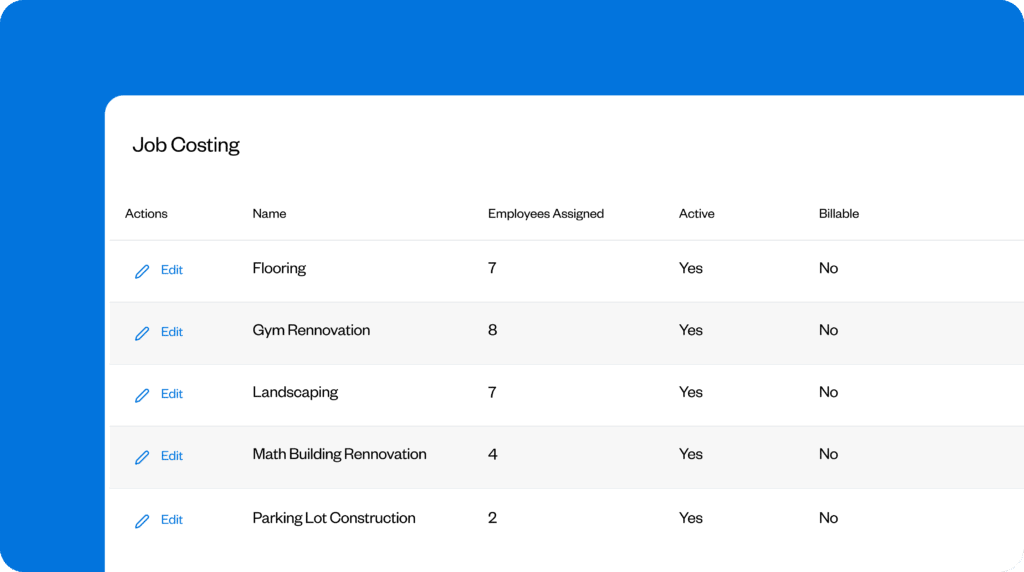
Buddy Punch’s job costing feature makes it easy to track time spent on specific jobs or projects. Simply create job codes and assign them to the workers who are on those jobs.
When employees clock in, their time will either automatically be attached to the job code they’ve been assigned, or if more than one job code is assigned, they’re presented with a job code list to select from when clocking in.
Project-specific pay rates
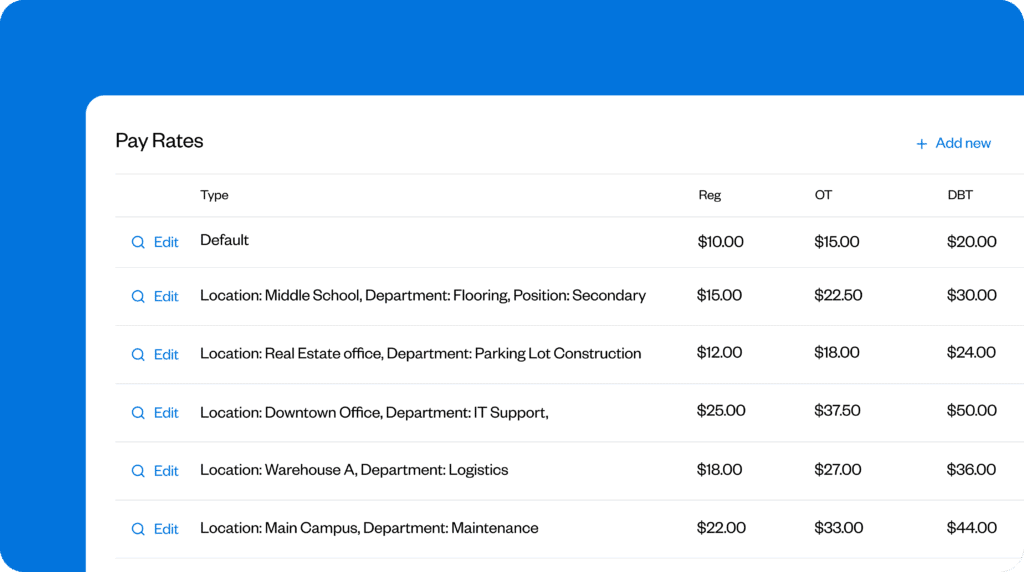
Set up different pay rates for the different projects your crew works on. This is helpful if your employees earn more when working on specific types of projects, such as prevailing wage jobs. When employees select a job code with a pay rate that’s different from their default rate, Buddy Punch will automatically factor in the higher rate for those hours when calculating overtime rates and total pay for the pay period.
GPS tracking
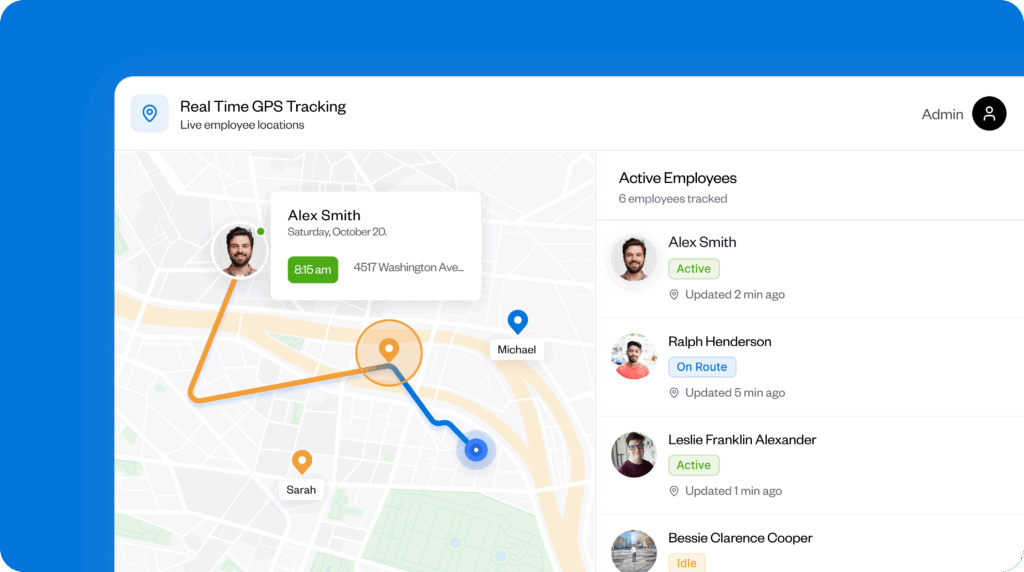
Buddy Punch offers two different GPS tracking features.
With basic GPS tracking, Buddy Punch will log your employees’ location data any time they clock in or out. You can review their locations on their timesheets and in your reports to make sure everyone was on site when they clocked in for work and clocked out at the end of the day.
If you want more advanced GPS tracking, Buddy Punch also offers real-time GPS where you can track employees’ locations for the entire time that they’re on the clock. You’ll be able to see everyone’s locations on a map at any time and view breadcrumb trails of their movements throughout the work day. This feature is especially helpful for tracking exactly where employees are, at what time, and for how long.
The nice thing about Buddy Punch’s GPS tracking features is that they’re completely customizable. Make it required for everyone, optional for everyone, or required only for specific employees you specify.
Geofencing
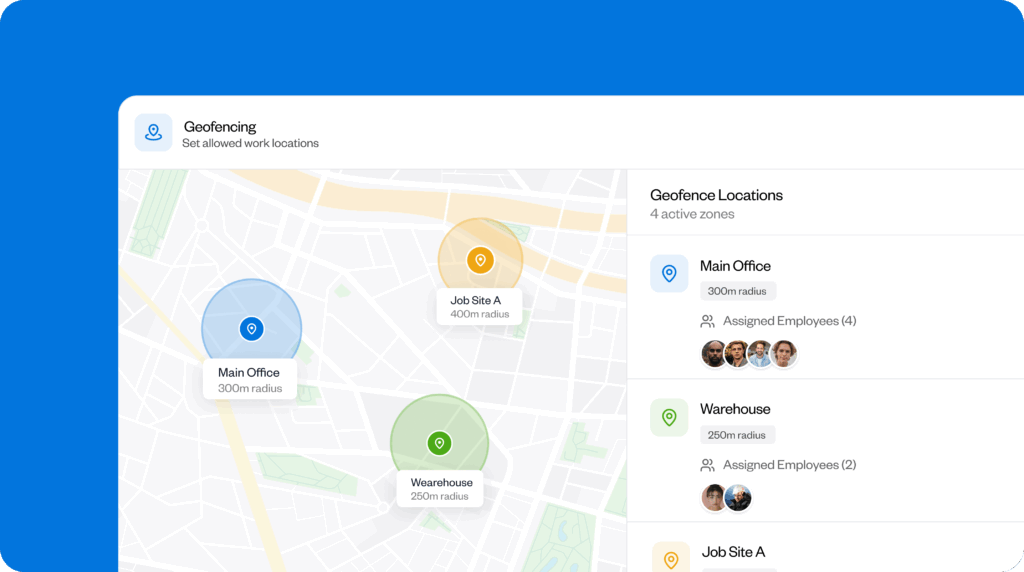
With geofencing, you can create virtual boundaries around multiple locations and limit clocking in and out to within those boundaries. You have complete control over the size of the boundary. Limit it for small office locations by making the radius 150 feet in diameter, or expand it for large job sites to as much as 4,500 feet.
After employees have clocked in for the day, geofences can also be used to send them notifications when they arrive at or leave a work site. This is helpful for ensuring that employees remember to change job codes when leaving the site of one project and arriving at the site of another.
You can also pair geofences with job codes to automatically tie an employee’s work hours to the job code of the specific location they’re working at. This means your workers won’t have to worry about selecting the right job code when switching between two sites on the same day. They just arrive at the worksite and punch in, and Buddy Punch will take care of the rest.
Group punch
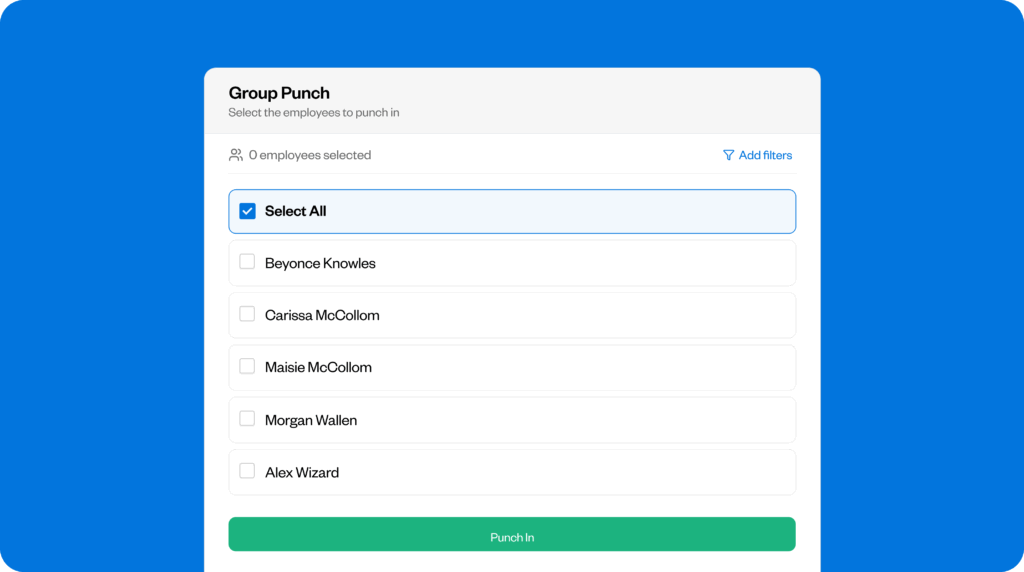
If you don’t want to bother asking your employees to download Buddy Punch’s mobile apps (or if they don’t have mobile phones), you can allow your foreman to clock everyone at the worksite in and out at the same time. This is great for crews where everyone’s working the same shifts at the same time.
Spanish translation
While the default for Buddy Punch’s app is English, it can be completely translated into Spanish in a single click. Once employees select the Spanish version of the app, it will continue displaying in Spanish for future logins. This is great for multilingual construction crews.
Other key features
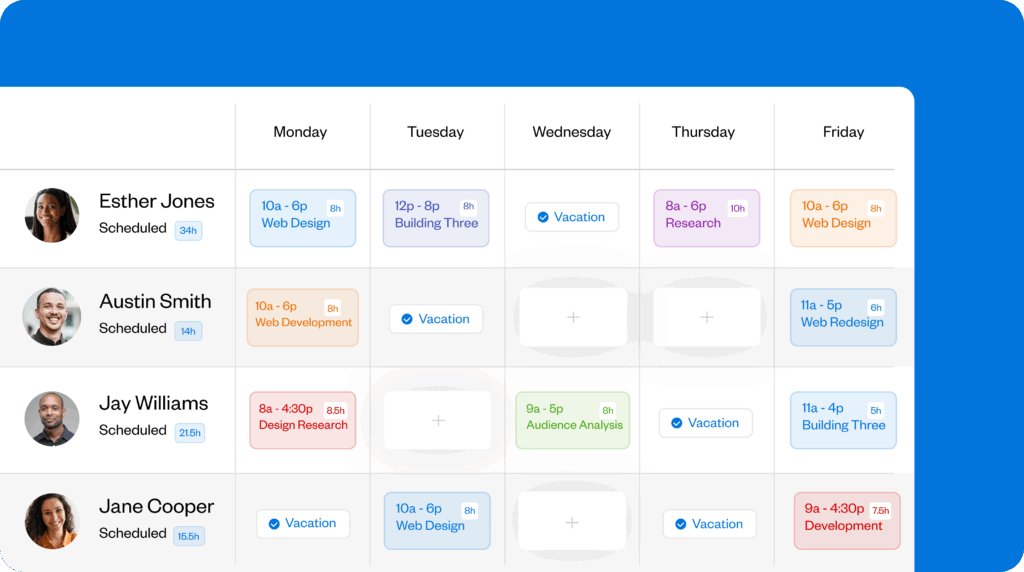
In addition to the construction-specific time tracking features listed above, Buddy Punch also offers:
- Time card approvals: Require site foremen to review and approve timesheets before you run payroll to avoid errors and rework.
- Break time tracker: Set up break rules in Buddy Punch to automatically remove unpaid breaks from employees’ timesheets so they don’t have to clock out and back in for lunch.
- Notifications: Get an alert when an employee is nearing overtime, when timesheets need to be approved, when an employee clocks in late, and much more.
- Payroll integrations: Instantly connect your time data to payroll and accounting systems like QuickBooks Online, ADP, Gusto, Rippling, Workday, and Paycor.
- Employee scheduling: Buddy Punch’s construction employee scheduling software makes it easy to create schedules for your crews and assign workers to specific locations and roles. Your workers can view their schedules anytime in the app.
- PTO tracking: Set up automated PTO accrual rules, update PTO balances and add paid time off to timesheets automatically, and let employees make time-off requests that managers and admins can review and approve or deny.
Customer reviews
- “We are a construction company. When our guys go out in the field they can use Buddy Punch; when they are in our warehouse they can use Buddy Punch. Since we have been using Buddy Punch, employees’ timesheets and what they are working on are more accurate.” Read the full review.
- “Buddy Punch is extremely easy to use and navigate. The use of the mobile app allows employees to clock in at multiple locations but can also show GPS coordinates if you’re questioning an employee’s whereabouts at the time the punch was entered.” Read the full review.
- “Completely simplified payroll for my hourly employees. I went from chasing down manual timesheets to printing a one-page recap for the pay period. I also love the GPS function to verify their location when punching in and out.” Read the full review.
Pricing
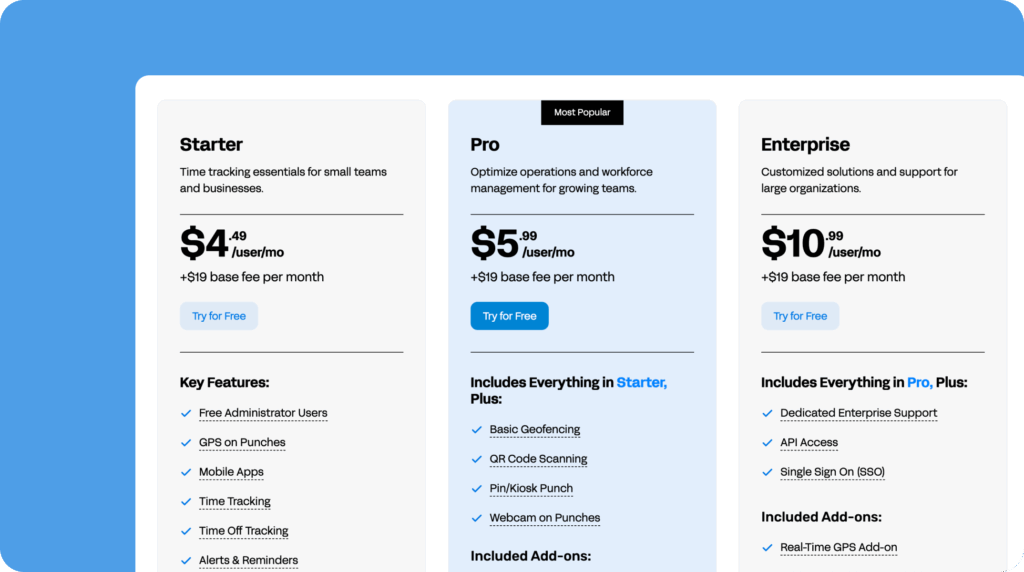
Buddy Punch is one of the lowest-cost construction time tracking apps on this list given its breadth of features. Prices start at $4.49/user per month plus a $19 base fee that covers the cost of all admin users.
Learn more about Buddy Punch
- Start a free trial — no credit card required
- View pricing
- Watch a video demo
- Take an interactive product tour
- Request a personalized demo
2. Workyard – Best construction time card software for certified payroll reports
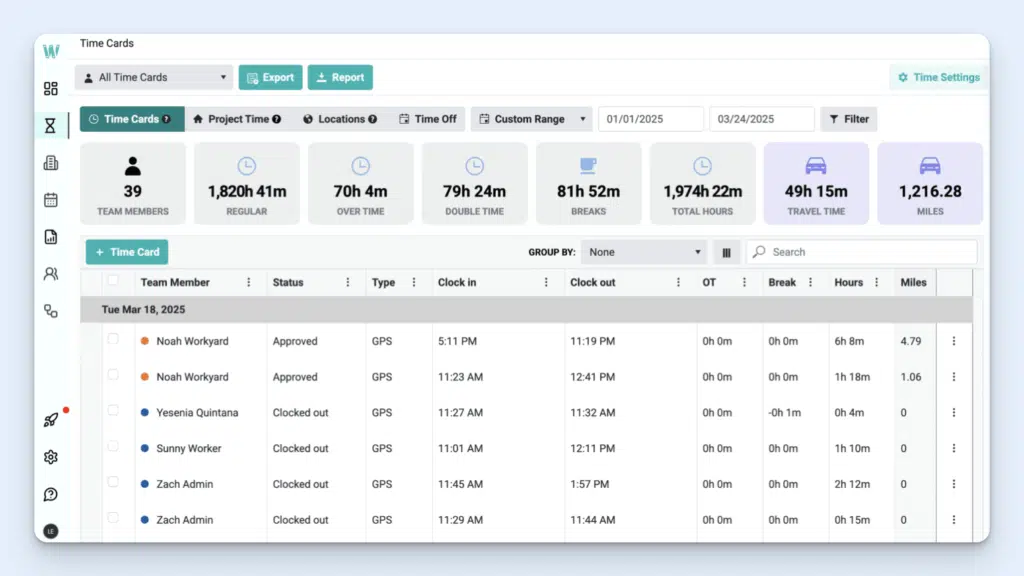
Workyard is a time tracking app that’s built specifically for construction companies. Beyond basic time tracking, it comes with lots of features that cater specifically to the way construction companies work, letting you include Workers’ Comp in your payroll, giving crews tools to upload project progress photos, giving you access to certified payroll reports, and offering integrations with other construction programs.
Precision GPS tracking and route mapping
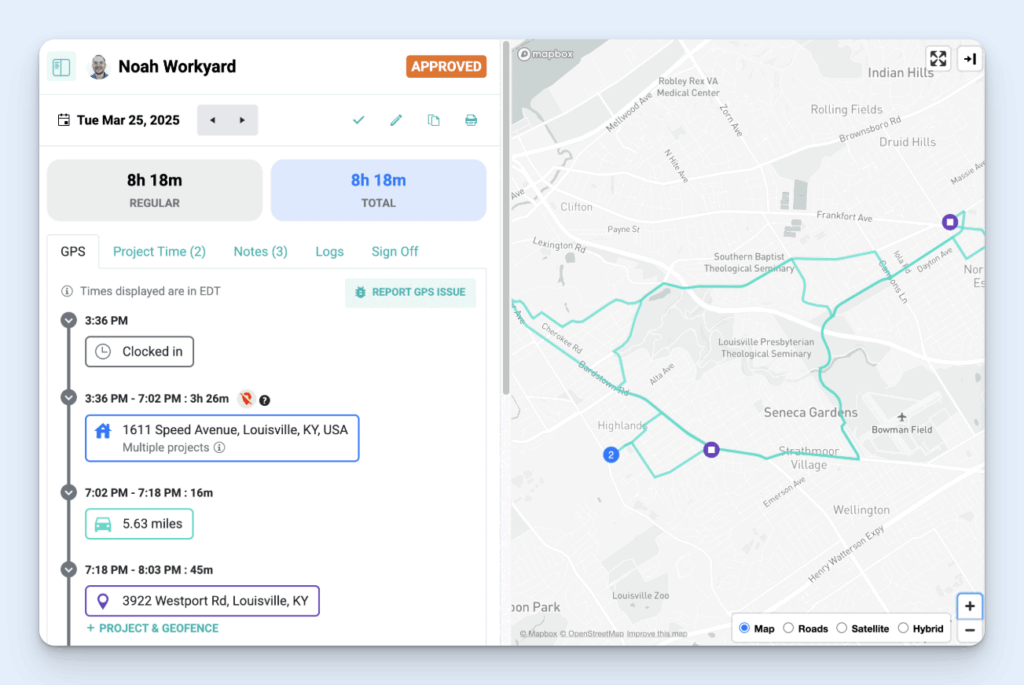
Workyard’s GPS tracking features are highly accurate and let you track employees, equipment, and materials. You can also use its route mapping feature to visualize employees’ travel routes and see exactly how much time they spent at different job sites. Mileage tracking is also available if you reimburse employees for mileage.
For employees who are already clocked in, you can also automatically clock them in and out from different job codes as they travel from location to location. Simply set up geofences and attach them to their appropriate job codes. Then, you’ll be able to track exactly how much time they spent at those job sites without the employee having to remember to switch job codes.
Construction-specific payroll features
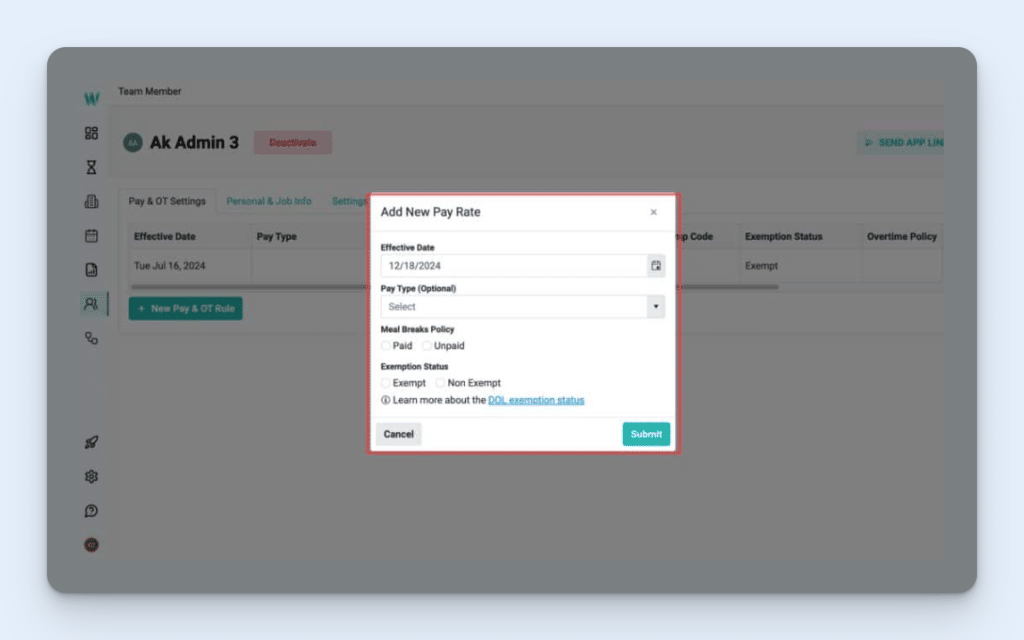
One of the standout features of Workyard is its ability to include Workers’ Comp in your payroll. Simply edit the pay for the employee who’s on Workers’ Comp, and then you can add an effective date, Workers’ Comp code, and the applicable pay rate.
Additionally, Workyard can also generate certified payroll reports. This legal report is required for any project funded by the government (federal, state, or local) that exceeds $2,000, as mandated by the Davis-Bacon Act. Workyard simplifies this notoriously difficult process by automating the data collection needed to fill out the federal WH-347 form (or state equivalents).
You can also assign specific prevailing wage rates to different projects to ensure workers are paid the correct amount for government projects. When a worker clocks into a prevailing wage project, the app automatically applies the correct hourly rate and fringe benefit amount based on their job classification.
Construction software integrations
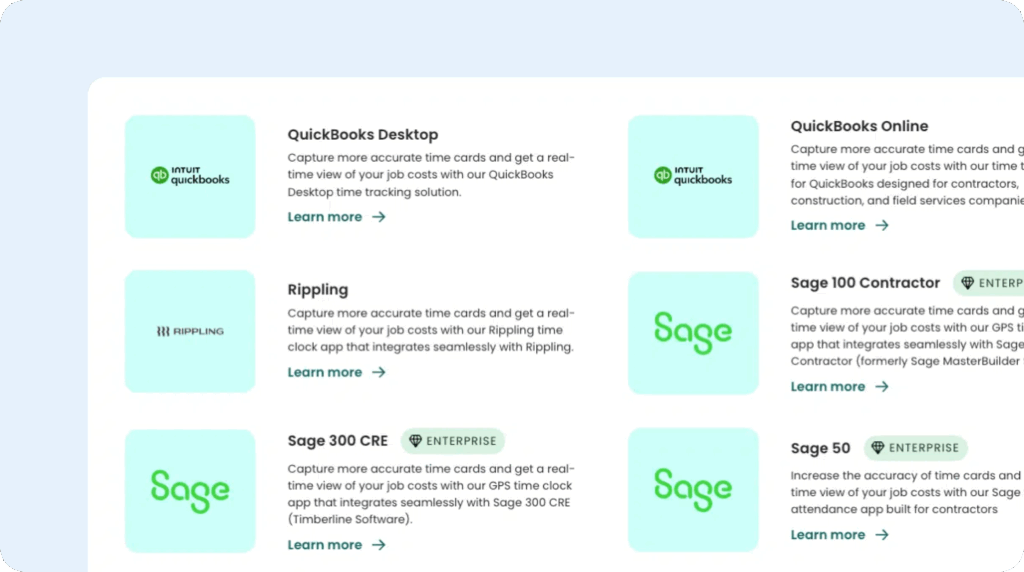
While most construction time card systems will allow you to integrate with popular payroll and project management tools, Workyard takes it a step further by letting you integrate with popular construction platforms like Foundation Software, Sage 100 Contractor, Sage 300 CRE, and ComputerEase.
Customer reviews
- “I can view the workers’ locations at each job site, which is very helpful. If they forget to log their tasks or projects, I am still able to check their location history and enter the time for each project afterward.” Read the full review.
- “It makes time tracking simple for everyone. Even the crew members who are not very tech friendly picked it up right away. They just open the app, tap twice and they are done. I can see exactly how many hours went into each job and send invoices without double checking everything.” Read the full review.
- “It’s easy to see who’s on site and when they started. The GPS accuracy and time logs make payroll simple and clear. I can check site activity without calling anyone.” Read the full review.
Pricing
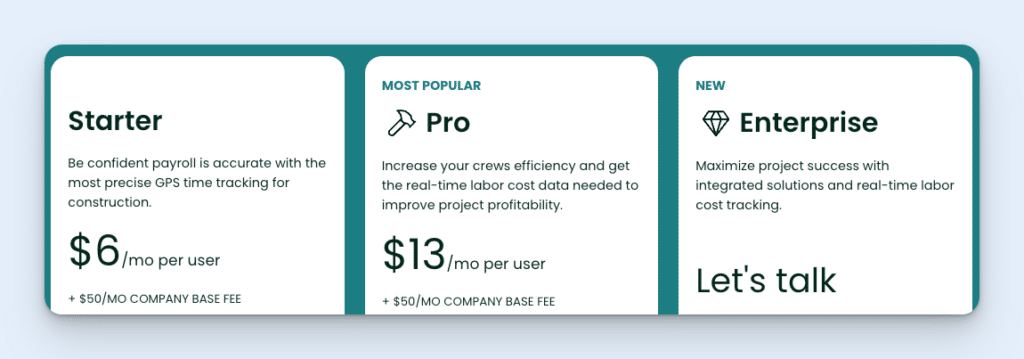
Workyard’s plans start at $6/user per month plus a $50/month base fee and include GPS and mileage tracking. To get access to geofences to restrict clock-ins to specific locations or automatically clock employees in and out when switching job sites, you’ll need to be on the $13/user per month Pro plan.
3. Timeero – Best construction time card system for offline tracking
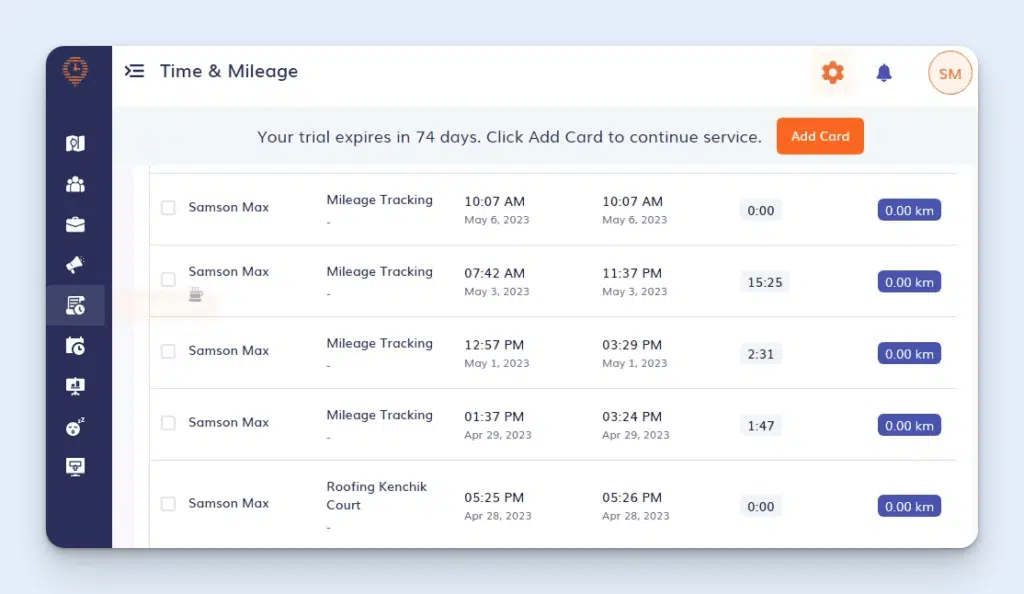
While Timeero isn’t built specifically for construction companies, it is built for teams that work in the field, making it another good option for mobile construction crews. It comes with all of the features mobile teams need: GPS tracking, geofencing, mileage tracking, and even offline tracking for teams that are working at sites that don’t have strong cell phone signals.
Offline tracking
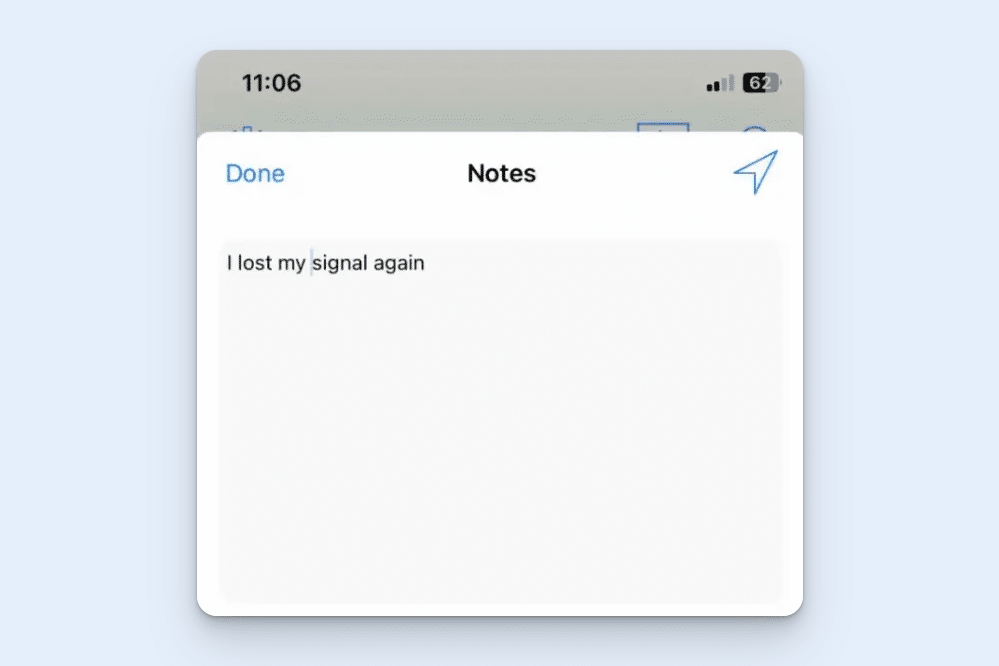
If your team often works in rural locations (i.e., places where cell phones don’t get a signal and can’t be used), Timeero has a good solution. When an employee loses their cell phone signal, it automatically logs their location, time, and mileage to their cell phone’s local storage and then uploads it to Timeero’s system when they’re back online.
Segmented time tracking
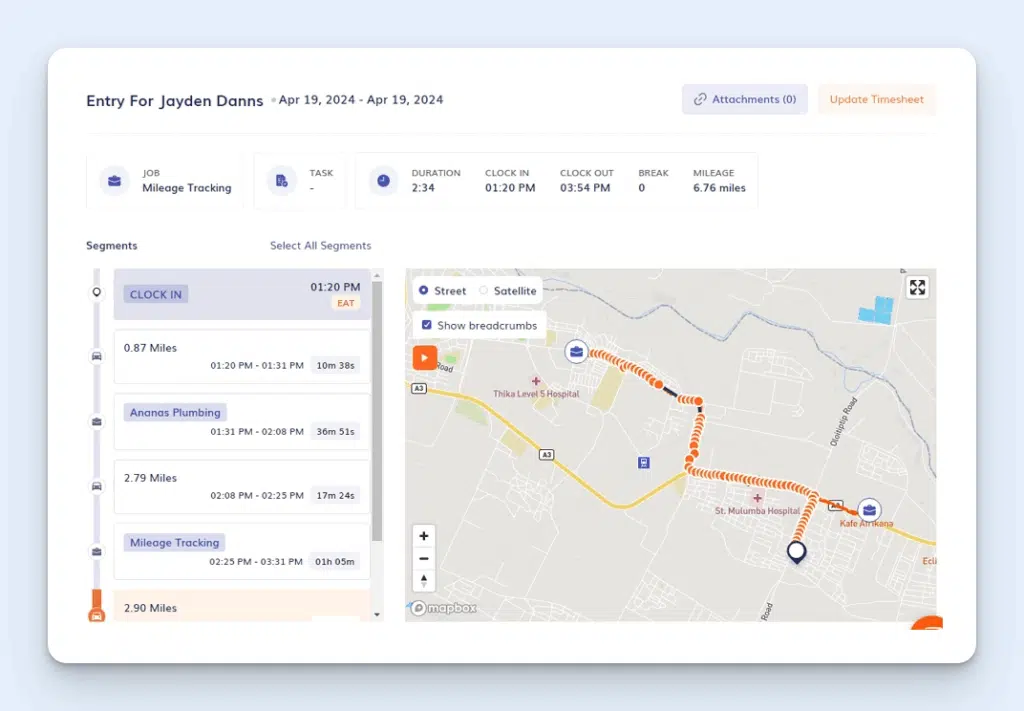
Timeero’s segmented time tracking feature is great for crew members and foreman who travel to multiple job sites over the course of a day. Employees only have to clock in once at the start of the day. After that, the app will detect when they arrive at and leave your geofenced job sites, automatically applying the time spent at those sites to the appropriate job codes.
Beyond job costing, Timeero’s real-time GPS and segmented tracking features will also show you where employees traveled while they were on the clock, calculate exactly how many miles they traveled, and give you reports on exactly how much time they spent at each job site. You can view all employees’ locations at any time on a map or view breadcrumbs showing their movements across the work day.
Geofencing
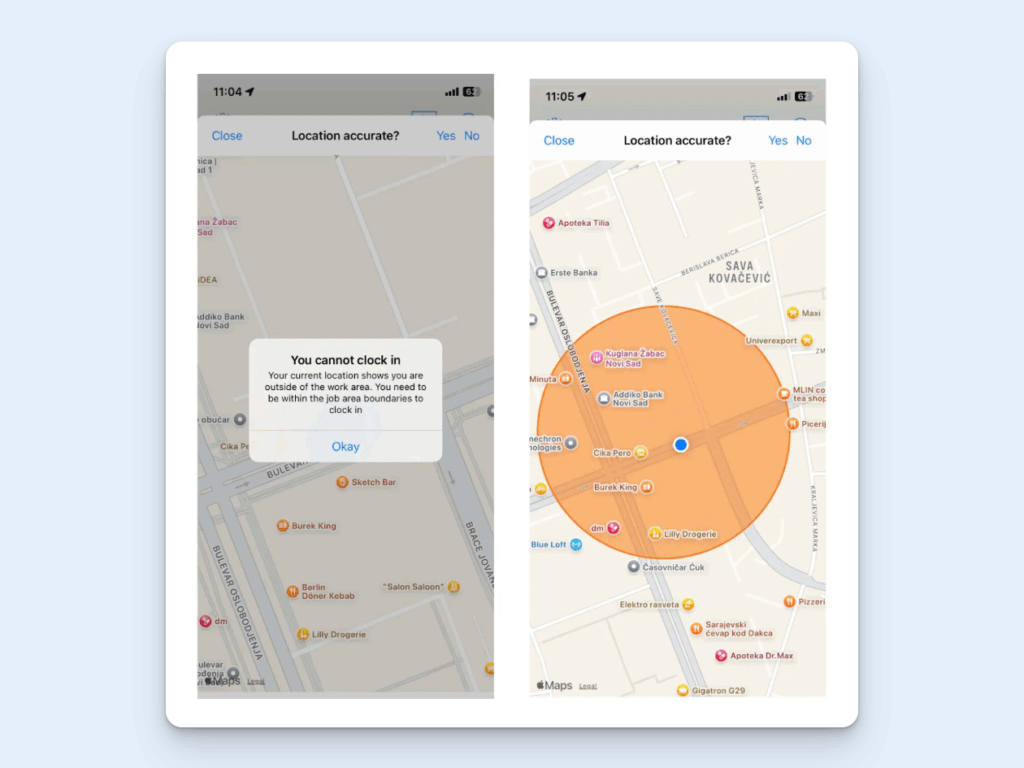
Timeero’s geofencing feature gives you a lot of flexibility. You can use it to prevent employees from clocking in/out when they’re not on the job site, remind them to clock in/out when arriving at or leaving a job site, or automatically clock them in/out when arriving at/leaving a job site.
Additionally, if employees often work in areas with poor cell phone reception, you can give them the option to override the geofence and clock in/out anyway. When doing so, they can leave notes in the app to let admins and owners know why they had to override the geofence rules.
Customer reviews
- “Ease of use for my crew is the most important aspect, as well as the amount of money we save on payroll and liability due to having everyone’s locations via GPS.” Read the full review.
- “Timeero has made daily time clock and mileage tracking incredibly easy for both employees and managers alike. The California specific settings have been a great help as well for dealing with California’s stringent labor/break laws.” Read the full review.
- “It is easy to integrate with QuickBooks. My staff were able to use it with very little aid. It has saved me money with the GPS log in for the staff. The cost is very reasonable.” Read the full review.
Pricing

Timeero’s plans start at $44/user per year for up to 10 users and include time, GPS, mileage, and break tracking. Segmented time tracking is sold as an add-on for an additional $5/user per month. For companies with more than 10 employees — or to get access to Timeero’s geofencing feature — you’ll have to upgrade to the $88/user per year Pro plan.
4. Exaktime – Best construction time tracking app for multilingual crews
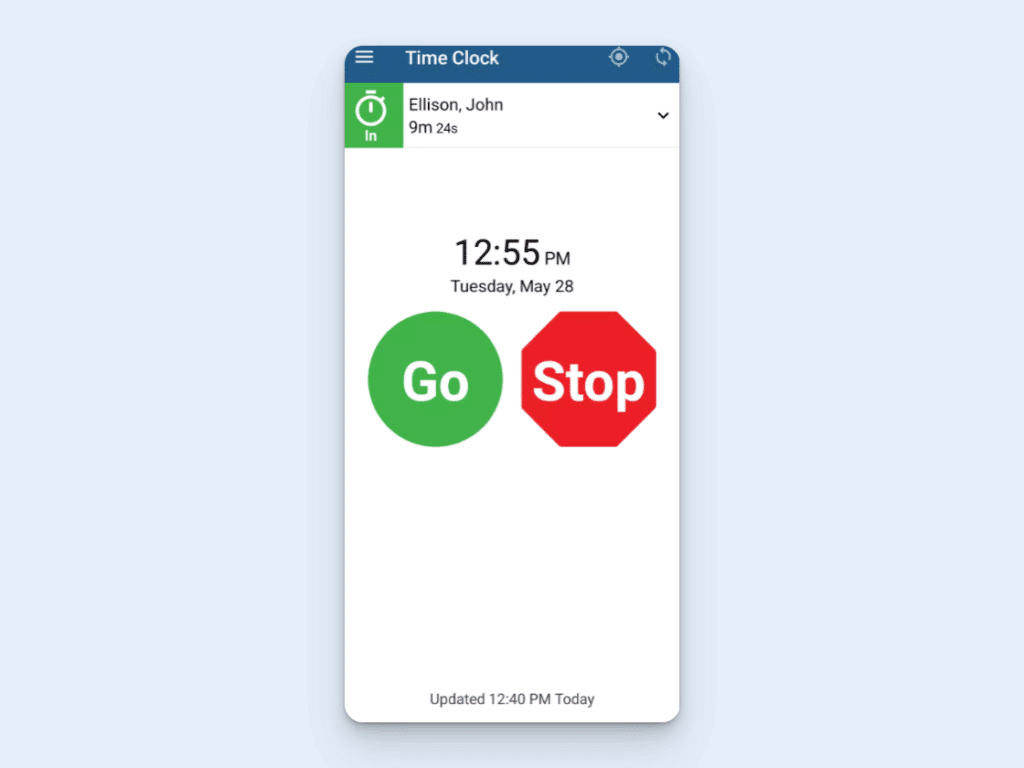
ExakTime is one of the most well-known construction time tracking apps on the market. It’s been around since 1999 and is 100% focused on the construction industry. And while it’s designed more for large construction companies with complex operations than it is for small construction businesses, it does offer a $9/employee per month plan that accommodates small business budgets.
Multi-language interface
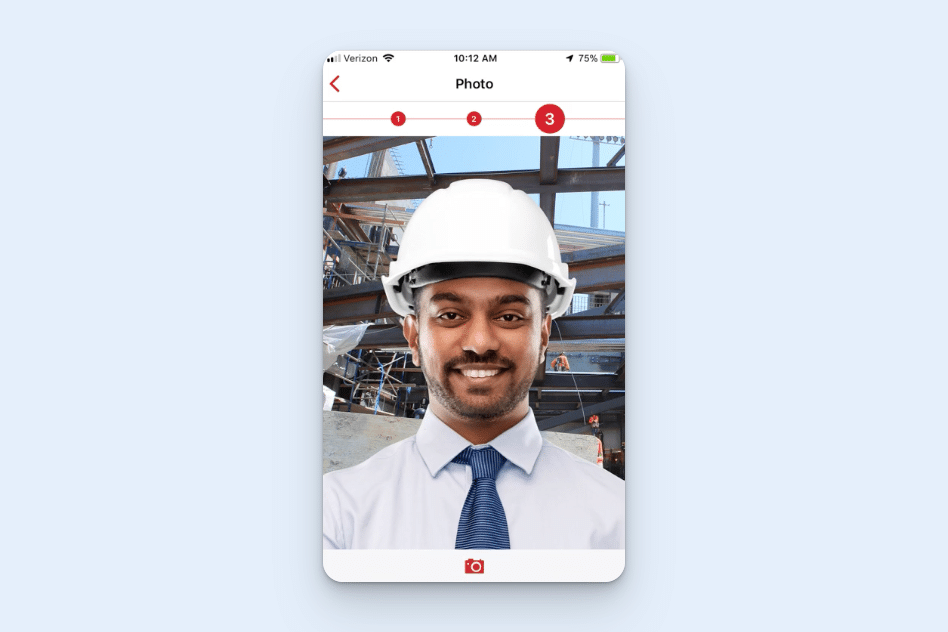
One of the standout features of ExakTime is its in-app translations. Employees can choose their default language when signing up — English, Spanish, and French are available — and the app will always show all its text in the selected language in the future. While other apps in this list also offer Spanish translations, ExakTime is the only one that includes French translations.
Physical time clock kiosks
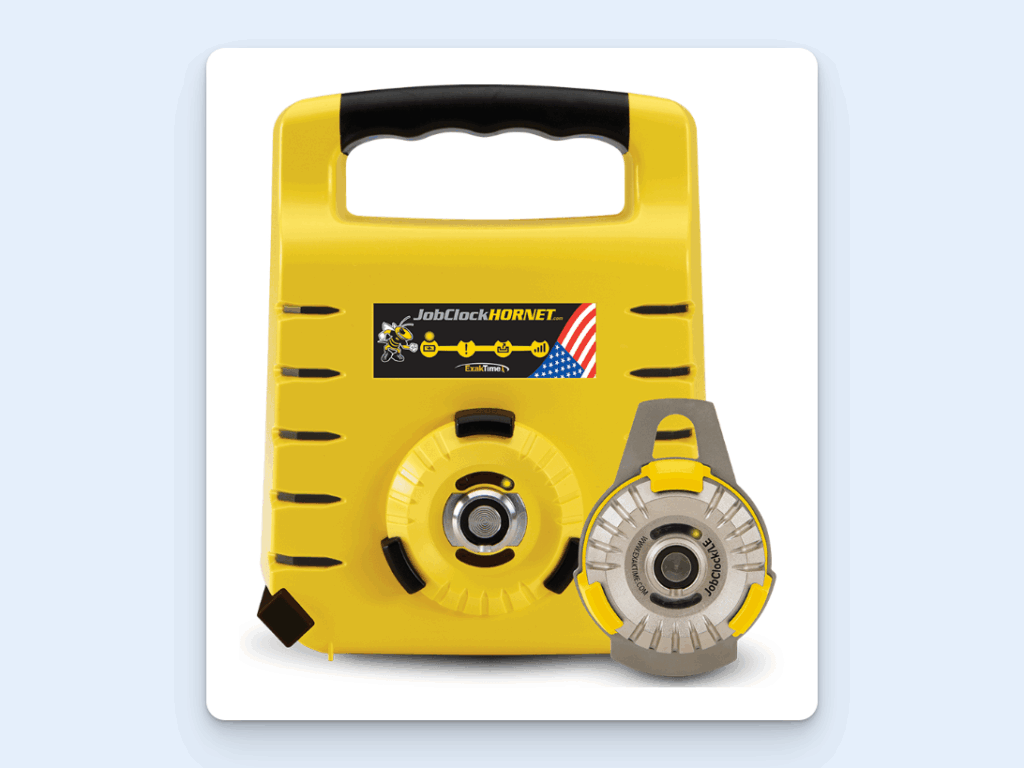
If you don’t want employees having to clock in using their mobile phones, you can purchase one of ExakTime’s portable time clocks. These devices are waterproof, weatherproof, and durable enough to withstand the rough conditions of construction worksites. Employees can clock in and out on the portable time clocks using individually assigned RFID badges or key fobs.
Employee, equipment, and material tracking
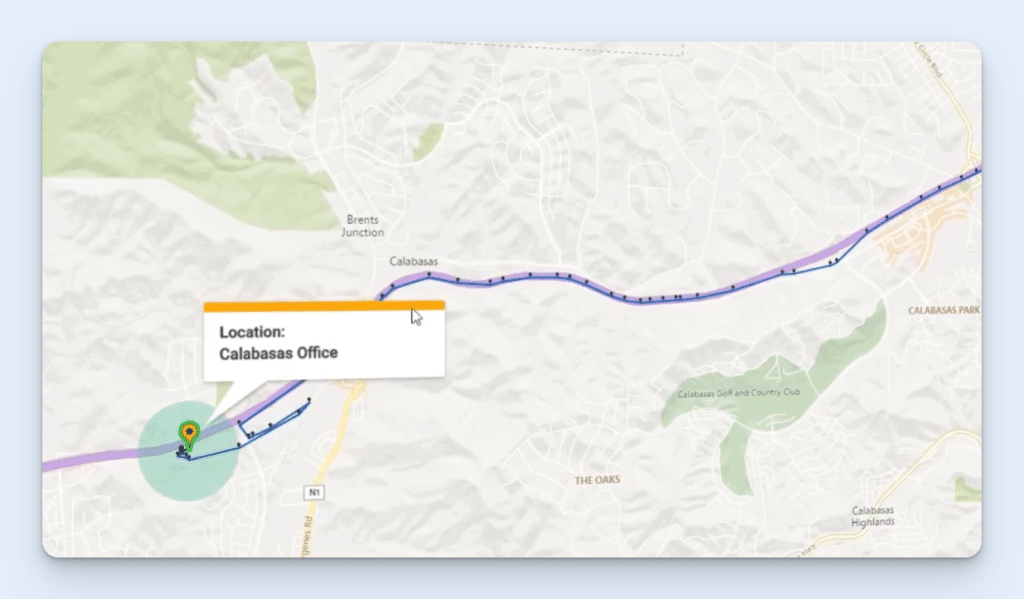
Like the other apps on this list, ExakTime comes with employee location tracking features like real-time GPS tracking and geofencing. You can even use it to track the locations of your tools and heavy equipment. Plus, ExakTime’s inventory management feature lets you monitor usage of and inventory levels of all of the materials you have at each job site.
Pricing

Plans for ExakTime’s construction time card software start at $9/employee per month plus an undisclosed base fee and include GPS tracking, geofencing, and time and break tracking. ExakTime’s portable time clocks and their companion RFID badges/key fobs are sold separately.
5. ClockShark – Best construction time tracking solution for getting real-time updates from the field
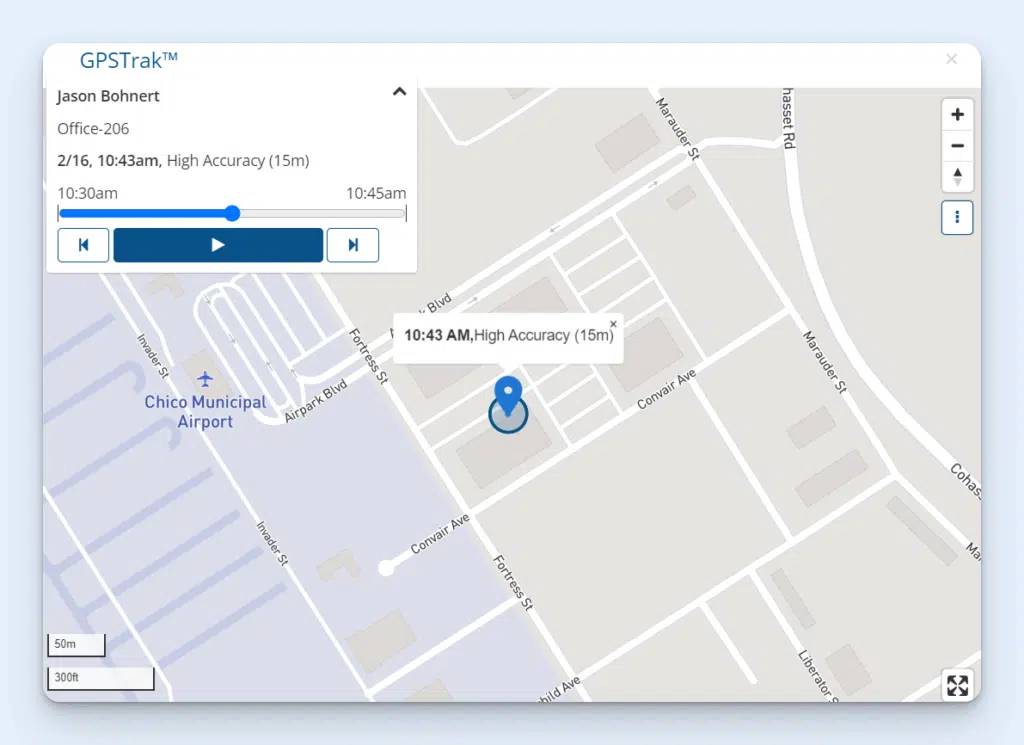
ClockShark is another construction worker time card app with all of the standard features that construction companies need: time tracking, scheduling, GPS monitoring, geofencing, facial recognition, and job/task codes. Additionally, ClockShark has built-in Spanish language support.
Clock-out questions
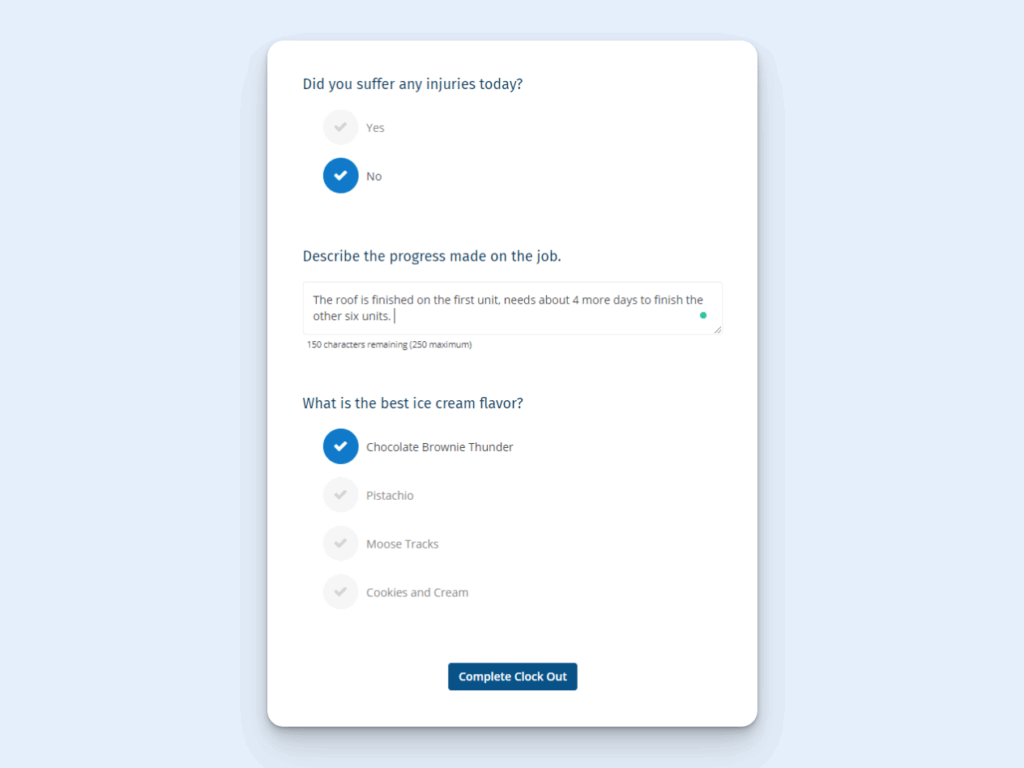
ClockShark’s most unique feature is clock-out questions. To track project progress, you can ask employees to provide updates, photos, or documentation when they clock out. This information is automatically forwarded to the office to help supervisors and admins keep track of the progress of projects even when they can’t be in the field.
Conversations
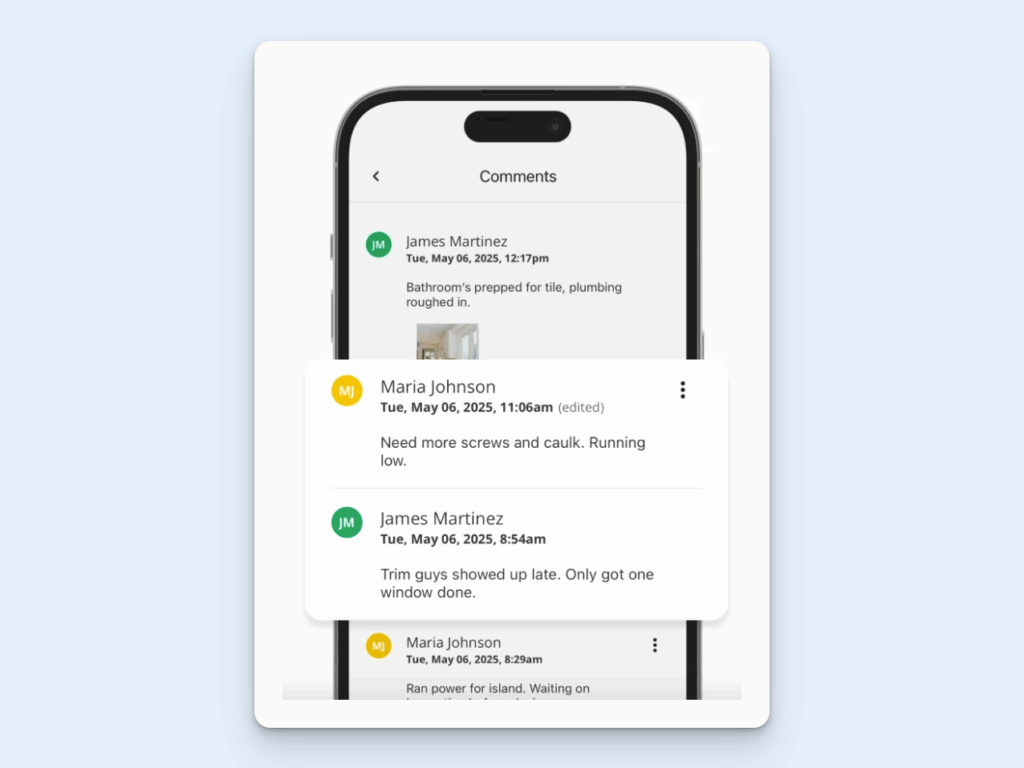
In addition to the more asynchronous clock-out questions, crew members, project managers, and admins can also communicate with each other in real time using ClockShark’s team chat feature, Conversations. Unlike clock-out questions, Conversations are not tied to timesheets and can be used to ask questions and get less formal updates while employees are working.
Document sharing
If you have project plans, blueprints, contracts, or other documents that crews need to access while they’re at a worksite, you can upload those documents to ClockShark so employees can access them in the app. This can also be helpful if you need to collect receipts for expenses incurred in the field; employees can just take a picture of the receipt and upload it to ClockShark.
Customer reviews
- “My company was reluctant to switch to electronic timekeeping because change can be difficult to implement. However, ClockShark offers excellent training articles, videos, and live support so everything from the integration to training our staff was a breeze.” Read the full review.
- “The platform is very intuitive and makes running a business that covers multiple different locations so very easy. I find myself using their tools more than I thought I would need to. And it was simple to implement into our business.” Read the full review.
- “Using ClockShark is easy. It doesn’t take a lot of training for our guys to get the hang of it. And ClockShark’s customer service is by far the best I’ve had to deal with in the last couple of years.” Read the full review.
Pricing
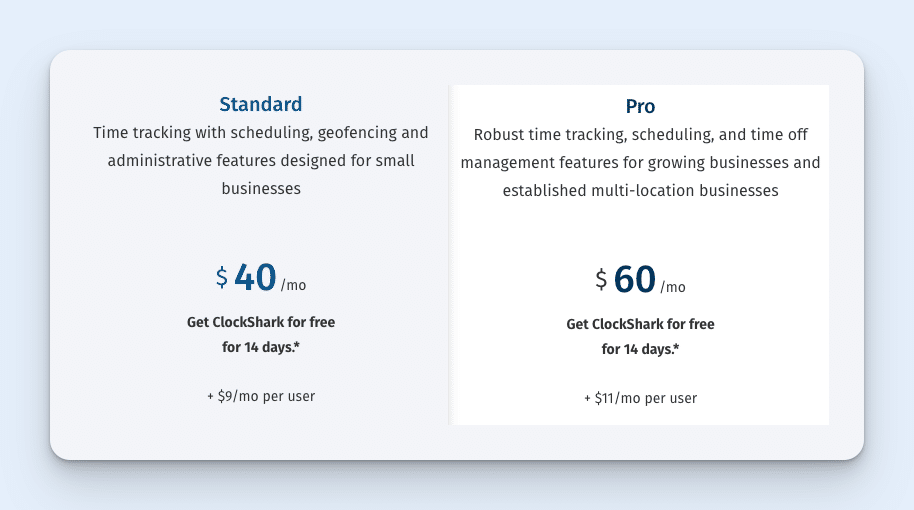
ClockShark’s plans start at $9/user per month plus a $40/month base fee and include time, GPS, and job tracking. To get access to clock-out questions, you’ll need to be on the $11/user per month Pro plan.
6. ConstructionClock – Best construction timekeeping app for automated time tracking
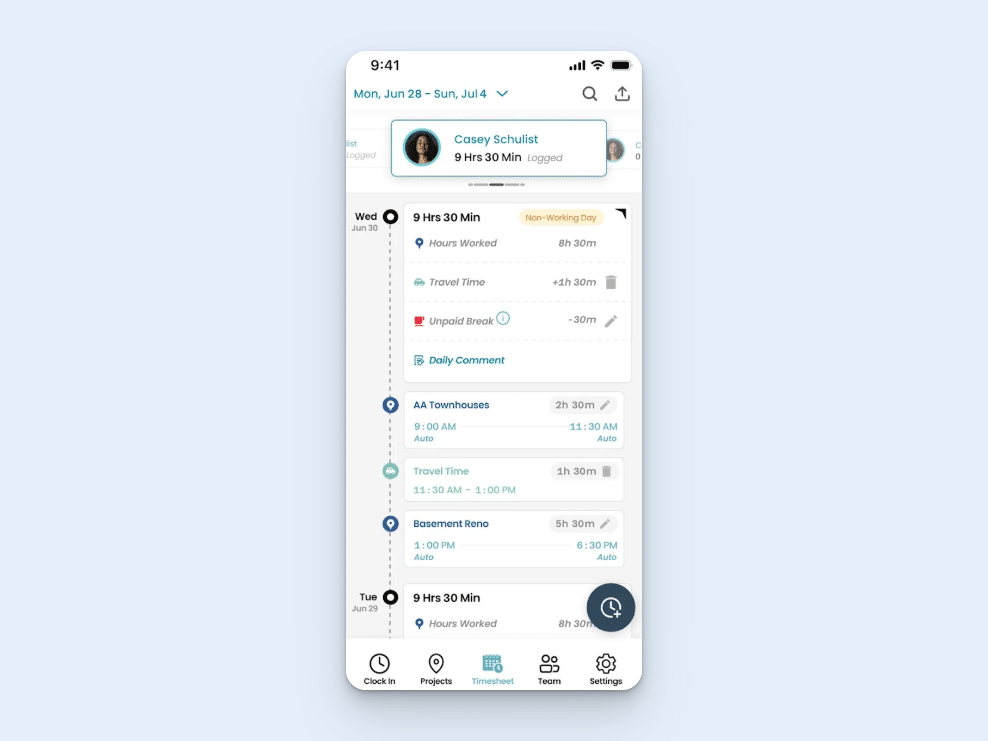
ConstructionClock is different from the other construction time card software in this list because it doesn’t have manual clock-in and clock-out functionality. Instead, it uses geofencing to automate time tracking based on when employees arrive at or leave a job’s location, giving you more accurate records of the actual hours spent at different worksites.
Additionally, if employees leave a site and return to it on the same day to do something like collect or purchase materials, ConstructionClock automatically logs those time entries as travel time and adds it to the employee’s billable hours.
High-frequency GPS logging
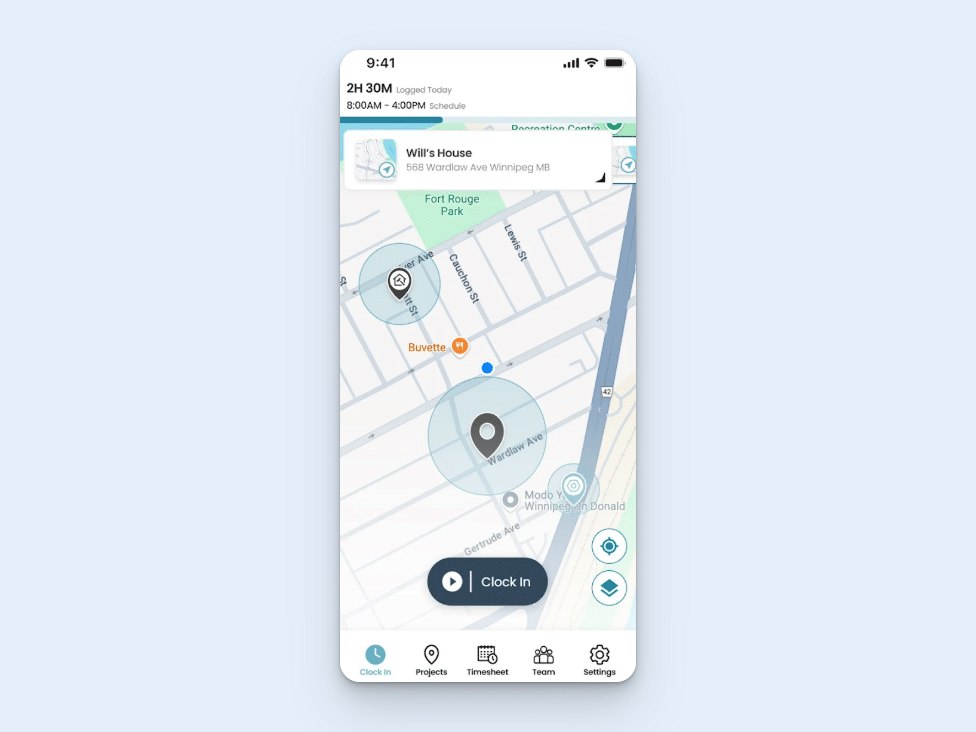
In addition to automatically clocking employees in and out, ConstructionClock offers high-frequency GPS tracking. It’s not quite real-time tracking, but employees’ locations are captured frequently to provide you with breadcrumb trails of their movements across the workday.
Task management
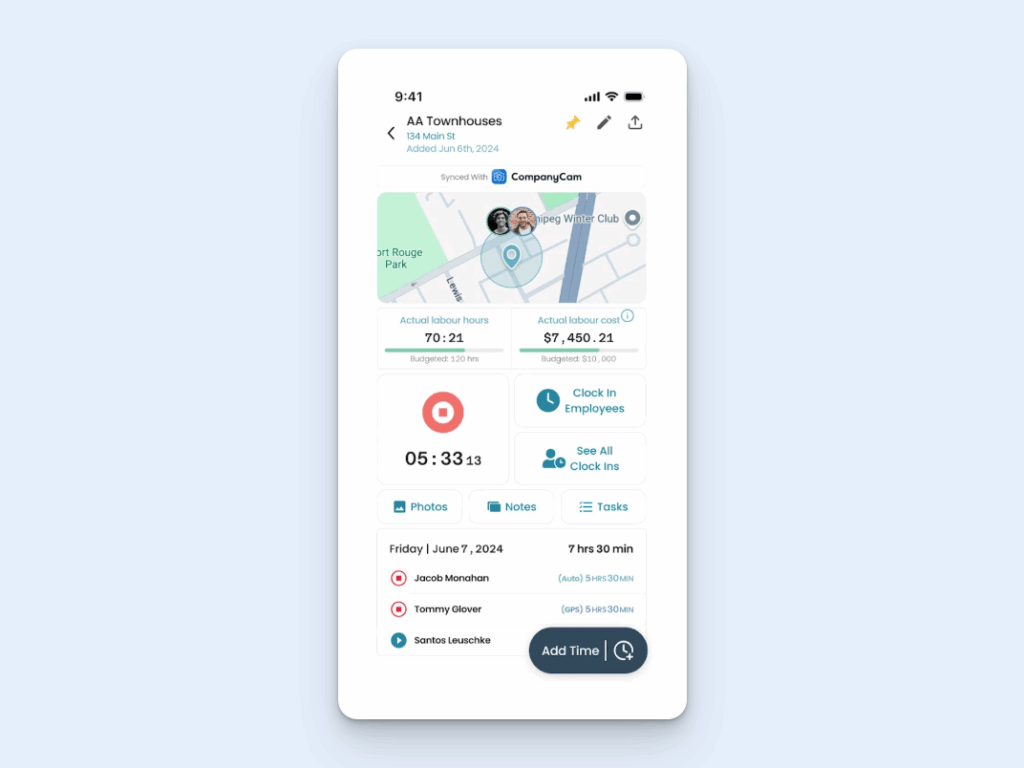
One of the most unique features of ConstructionClock is that you can also use it to create tasks and assign them to employees. This is helpful if you have newer employees who need more guidance to know exactly what they need to do for the job, and it can also help you keep better track of how a job or project is progressing.
Employee scheduling
Another feature you’ll find in ConstructionClock is employee scheduling, which allows you to create schedules for your crew members and assign them to the specific locations you need them to work at. You can also schedule employees’ breaks in ConstructionClock and even specify if those breaks are paid or unpaid. Unpaid breaks are automatically removed from timesheets.
Pricing
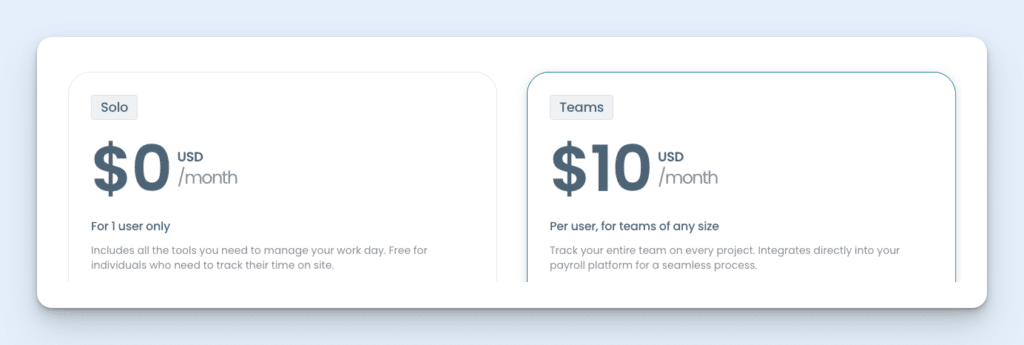
ConstructionClock does offer a free plan, but it can only be used by one person, so it’s really only useful if you’re a solo contractor. Its paid plan costs $10/user per month and includes all of the platform’s features.
7. BusyBusy – Best free construction worker time card app
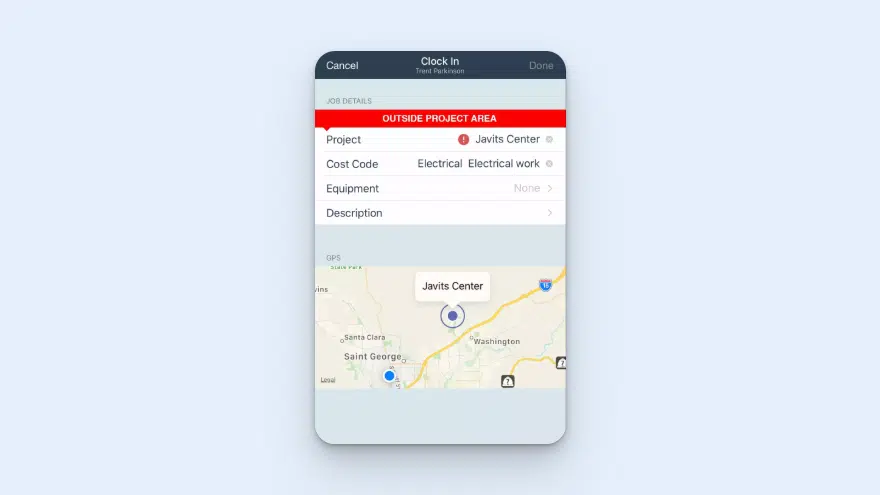
BusyBusy is a good choice for construction companies that want to switch to digital time tracking but can’t afford to pay for it. It has a generous free plan that lets you add unlimited users, track employees’ time, create job codes, and log employees’ locations when they clock in and out.
Equipment tracking
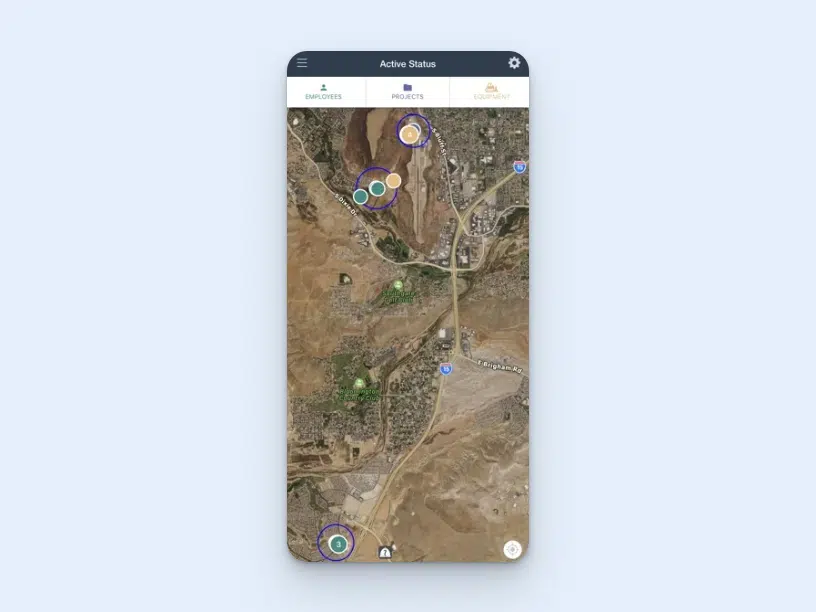
In addition to being able to track employees’ locations, BusyBusy also lets you track the locations of your heavy equipment on its free plan. You’ll be able to see where your equipment is located at any time on a map, which can be helpful if equipment disappears or if you need to know where a specific piece of equipment is located at the moment.
Paid plan features
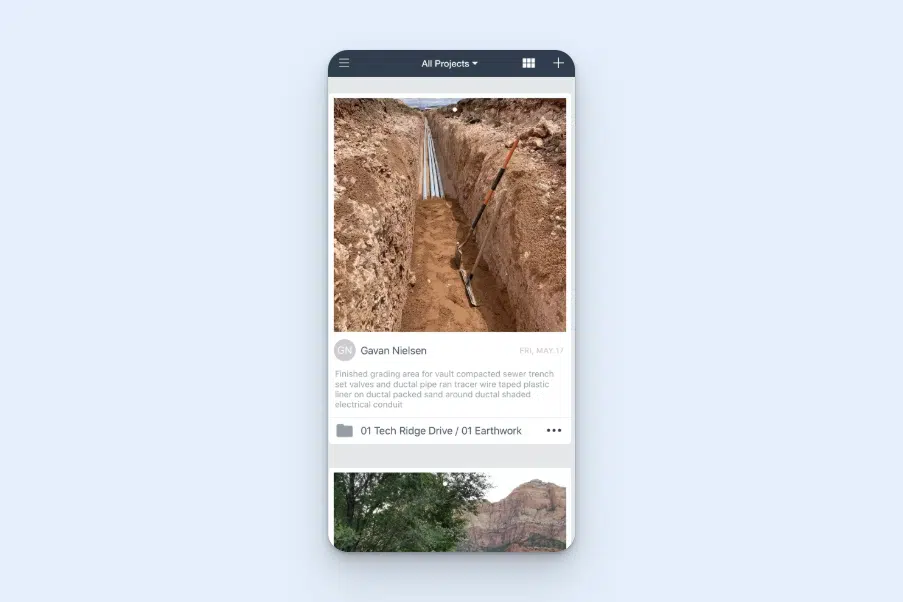
You get a lot more features when upgrading to BusyBusy’s premium plans, including GPS location history that allows you to see where employees were during their entire shifts, project photos where employees can upload images so you can track project progress, and a crew scheduling app to create employee schedules.
Safety sign-offs
Another unique feature in BusyBusy is safety sign-offs. This prompts employees to specify if they were injured on the job when they clock out for the day. If an employee does report being injured, BusyBusy lets you submit all of the required OSHA reports electronically. You can also view a complete list of all incidents that have been created in BusyBusy.
Customer reviews
- “We were using ExakTime in the past. It had great qualities as well, but this app has more features and a better price point and is more agreeable in terms of the billing process in that you only pay for users that are active.” Read the full review.
- “The best part of BusyBusy is how simple it is for employees to time in and out of projects. It is also simple to make corrections if needed and prepare for payroll.” Read the full review.
- “The app is very easy to use, even for those ‘Dinasours’ on our crew. Integration to QuickBooks Desktop is quite seamless. Customer service is great.” Read the full review.
Pricing
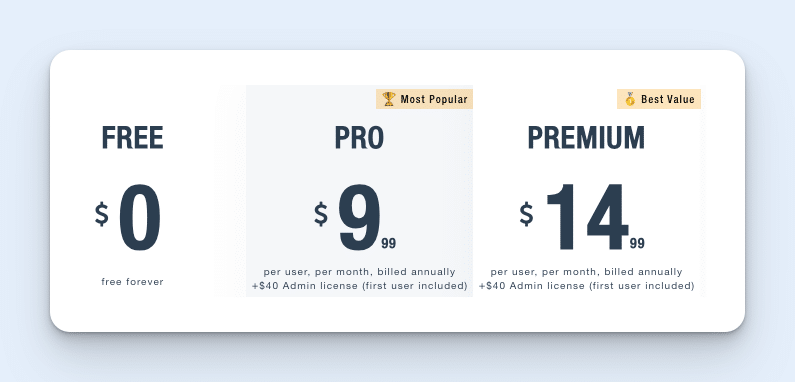
BusyBusy has a free plan that includes unlimited users and lets you track time, capture locations on clock in/out, set up job codes, and track equipment locations. Its paid plans start at $9.99/user per month and add in GPS breadcrumbing, safety sign-offs, and photo uploads.
Choosing the right time card app for your construction business
Hopefully, the information above helped you come up with a shortlist of tools to consider. However, in addition to considering features and reviews, there are a few other things you should evaluate to make sure that the construction time tracking software you choose is the perfect fit for your business:
- Free trials and demos: The best way to determine if a tool is right for your team is to see it in action. Getting hands-on in a free trial is the best way to evaluate a new time tracking app, but if a free trial isn’t available, get a demo so you can see it for yourself and ask any questions you have.
- Pricing and budget: Construction time tracking apps can be on the more expensive side, and some apps lock their best features behind their highest-priced plans. Make sure you fully understand what features you’re getting for the price you expect to pay.
- Customer service: Payroll is incredibly time-sensitive, and you’re inevitably going to run into issues from time to time when using a time tracking app. Try sending a few questions to the app’s customer service team to evaluate how quickly you can expect to hear back and how helpful the responses you receive will be.
By considering these additional factors, you can increase the likelihood that the app you choose will work well for your team for years to come.


